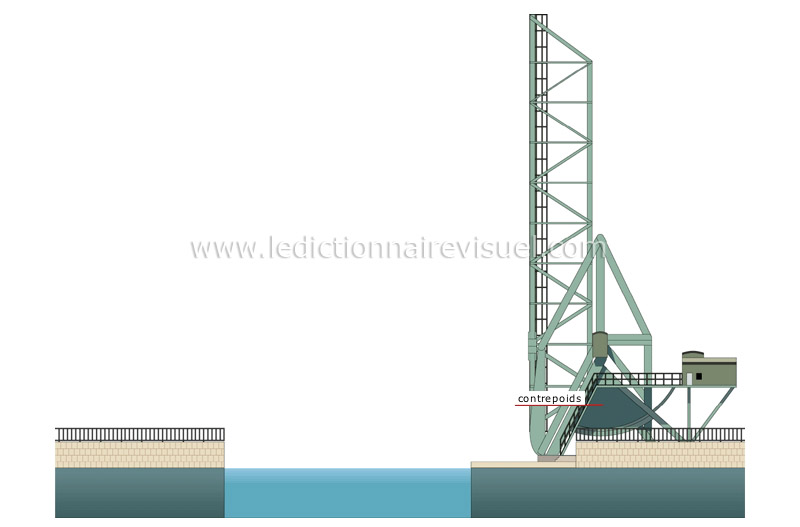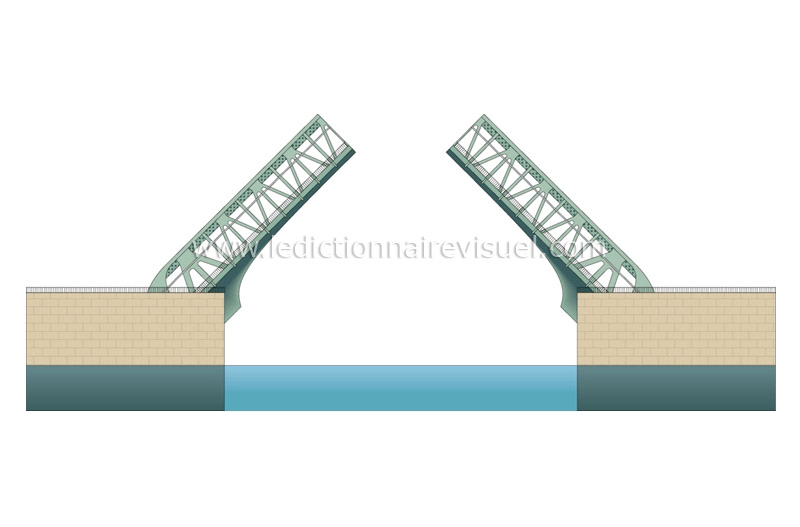Hello @vogue 103
Before going any further, we should make a synthesis because we have to read between the lines to get an idea of the CdC.
I suggest you make a PDF with a version number so that if you want to follow the epic, you can only open the latest version.
I will summarize some points:
Starting with (drawbridge and not Levi) because the word comes from the Latin levis (light) and also with the meaning of literally lifting lift bridge ( levant. Just as the sun rises.)
So before losing its Latin: I note that your project consists of proposing to a Maîrie to use a horizontal door that rises in a similar way to that of a drawbridge instead of a sliding gate.
Therefore, once lowered, there is no need for a moat because the deck of the bridge can rest on the ground: since it is not to make the pedestrian cross a moat but only to walk on a door placed on the ground.
I see some advantage in the absence of a moat, which is that you can absolve yourself of load problems and standards for this type of structure, which is a resistance of 500 Kg per m² corobored to the length. (otherwise splash in the Tarn)
The second advantage that you have very discreetly highlighted is that of weight. A large door (inspired by an isoplane, adapted to the width and length) will do the trick in the conditions of resisting water if the structure is outside.
I think your friends are talking nonsense with this story of loss at the end of a tree. I still hold my ribs with the story of the drill (I don't do MDR because I value life). All heavy goods vehicles but also cars have driveshafts long enough for six-wheel drive trucks.
Once the torsion is up to 5°, the torque is fully transmitted.
In fact, with a 40 mm tube and Ø 33 inter and a length of 3000 mm and a moment of 391 Nm you have a maximum angle of 4.4° and a T stress of 43.43 MPa (in other words, less than the games you will have elsewhere).
In addition, the maximum effort and when the floor is horizontal and the effort decreases the more you raise the floor. In addition, what needs to be lifted is not equal to the total weight of the floor but only half at the beginning.
Then instead of a chain you use a cable. Ok!! except that if you do a winding on a rim you will not have a constant torque for your engine (the torque increases at the same time as the diameter increases because of the winding on itself). That said, it's not a big deal, since the torque required decreases beyond 45° of lifting).
If the buckling of the drive shaft is correctly calculated and because you have a very low rotation speed and the end of the shaft takes only a quarter of the total floor, you don't need intermediate bearings at all, which are annoying to put on and especially to align on a wall or something else.
If we summarize
- Don't be afraid with the torque of the geared motor not very powerful (if we are in the case of a imitation door placed on a flat ground.
- Instead of using a rim you just have to put four flanges on your tube (two on one side and two on the other side).
- a single bearing that can be made of plastic on the side opposite the geared motor
- an elastic coupling between the geared motor and the lifting shaft as well as a simple crabo to prevent the motor from blocking and heating up if the limit switch (high door) is incorrectly adjusted or is HS).
- Provide a double safety device when the door is in the down position to prevent the cable from winding up in the opposite direction and raising the door.
I didn't understand what the IPN is for unless you think of them as the two right and left posts of the door. In this case, square tubes of 100 to 120 mm are more than enough and are also more aesthetically pleasing, ten times lighter and easier to fix in the ground and also less sensitive to torsion than an IPN only designed for certain types of forces.
The last question to ask yourself is if the through shaft can't simply be at the top of the square tubes (if no truck passes between the posts) then the tube at the top is better because it simplifies the returns and reduces the forces and it makes even fewer parts.
I'm good there!!!! Tell him where I am wrong and above all give the latest details on who or what passes between the posts. Depending on these details, I would give you an aesthetic tip.
Kind regards
 or
or 


